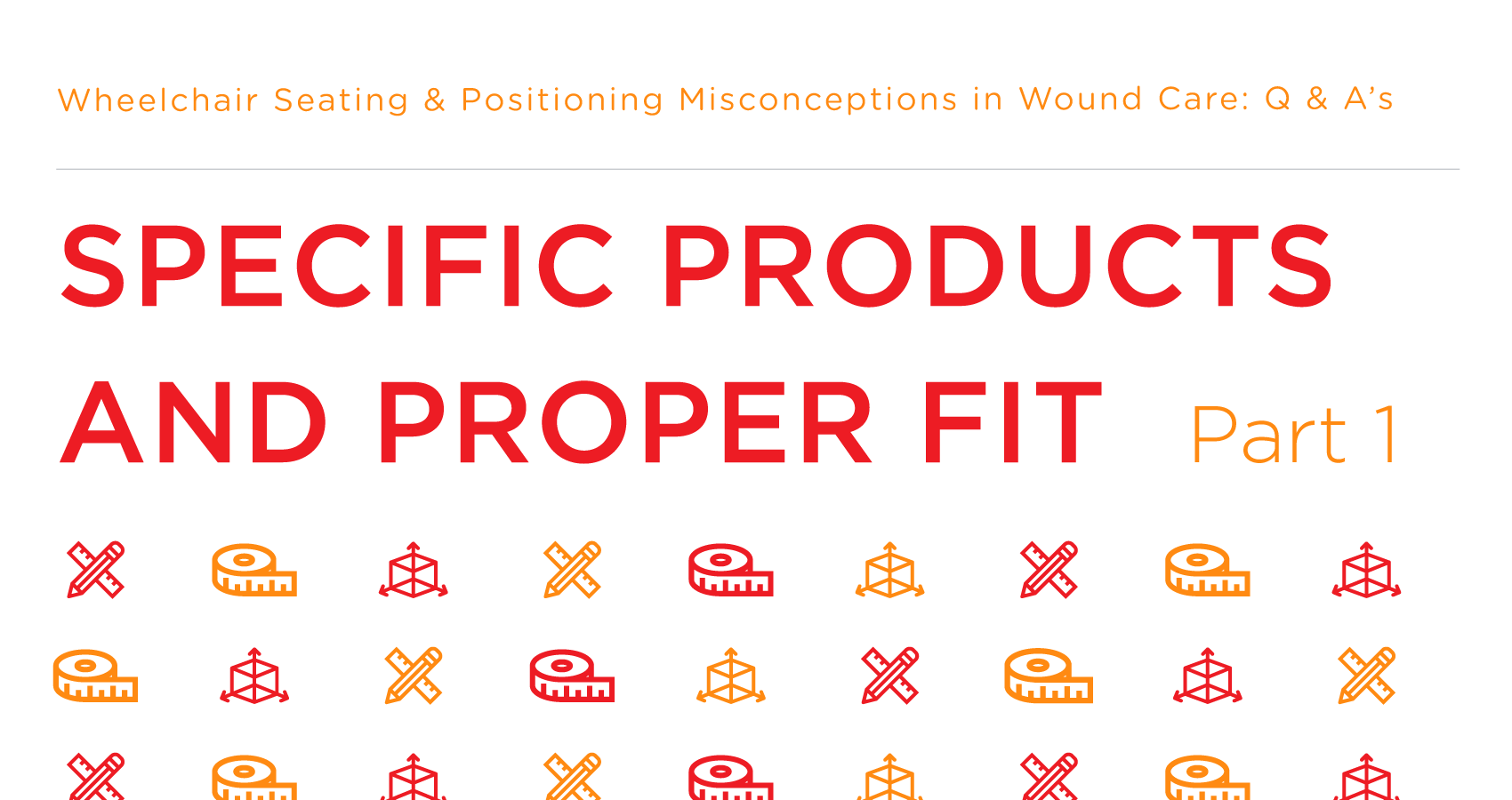Part 3 in our series Wheelchair Seating and Positioning Misconceptions in Wound Care: Q & A's where Lindsey Sharpe PT, DPT answers questions asked by participants of the webinar by the same name. This week we're focusing on questions about specific products and proper fit. See Part 1 and Part 2.
8. How do we go about finding the correct/appropriate cushion for the resident?
Oh, how I wish there was a specific formula! However, every patient is unique and different, and the appropriate cushion for that specific client will take looking at that patient as a whole. But, there are certainly some basic things to take into consideration with every client as you think through selecting the most appropriate cushion for that client!
The Ultimate Goal For A Cushion
We want to provide support to the pelvis to maintain the individual’s ideal posture and minimize peak pressures! This should:
- Decrease pressure at the bony prominences (ITs, Coccyx, Sacrum)
- Stabilize the pelvis in most neutral position possible
- Correct flexible deformities to prevent progression
- Accommodate fixed deformities to prevent progression and provide maximum pressure redistribution
- Minimize forward movement of the ITs (shear and posterior pelvic tilt)
- Provide optimal comfort
Assessment
Remember that the pelvis is the foundation; without the proper support at the pelvis, our trunk, LEs, head, and neck will collapse! Assess for postural abnormalities and evaluate whether these are fixed or flexible.
With the client in sitting on a firm, flat surface, use your hands to maneuver the pelvis and decide how much support your client needs and where your client needs it to achieve OPTIMAL sitting posture that is comfortable and most functional for your client. This will help you know what contours you will need on your cushion.
Also, we MUST think about and assess any skin breakdown/pressure injuries/risk of pressure injuries. By looking at their positioning AND skin protection needs, we will then choose either an immersion style or an offloading style cushion and take this into consideration as well.
Once you’ve done your full assessment and you have an idea of the issues, take some measurements
Measuring Tips:
- All measurements should be taken while sitting on a firm, flat surface in the posture the therapist is trying to accomplish for the patient.
- Measure using a hard measuring tape or calipers, if you have access to these. Do not use one that can bend and wrap around the patient’s body, that will lead to measurement errors, adding circumference or length.
- All measurements should be taken straight across the body.
- Measuring width: Using a hard measuring tape, measure at the widest aspect of the thighs/hips, always including redundant tissue.
- Measuring depth: Using a hard measuring tape, measure from the inside of the knee to outermost aspect of the buttocks, and subtract 2 inches.
Finally, all cushions are not equal. There are three areas to understand when choosing a wheelchair seat cushion:
Methods of Pressure Redistribution
Cushion Geometry
Cushion Medium
9. How do you know how to properly position a patient with a below the knee amputation?
This is actually fairly simple in theory. First, make sure your client is in the appropriate chair (I would recommend a K0004 or even a K0005, depending on the specific client), on the appropriate cushion, and has the appropriate back support. You will want to order an amputee support pad, which can be mounted various ways onto the chair.
How do I know what size to use?
Make sure you measure the width and length of the client’s residual limb as amputee support pads come in different widths/lengths; however, if you are ordering a pad that will belong to your facility versus a specific individual, I would recommend ordering a few different widths/lengths that you feel are “most common” to the clients you are seeing.
Typically, the width of the pad will be half the width of your wheelchair width. The length is typically between 10-14” and is meant to allow for full knee extension to prevent knee flexion contractures. Remember the length of the pad impacts the footprint of the chair! Make sure your client can maneuver doorways and hallways with the amputee pad in place.
How do I position the pad?
Always mount the pad level to the height of the cushion to prevent the risk of hip flexion contractures, or the risk of a pressure area if placed lower than the cushion height. These support pads have adjustable angles to allow you to achieve full knee extension for BKAs, or again, as much extension as possible to prevent hamstring contractures, as is the MOST COMMON occurrence post BKA.
By properly supporting the residual limb, you are minimizing the risk of high peak pressures and allowing your client optimal function in their wheelchair!

Above is a picture of a Comfort Company swing-away mounted amputee support pad, and here is the link to the amputee support options.
10. Is there any time that elevated leg rests would be helpful?
The only time I would recommend use of elevating leg rests is obtaining elevating leg rests that ALSO articulate/telescope, meaning the lower leg length can be extended/shortened as needed to match the leg length of the client. Elevating-articulating leg rests (combines elevation with ability to increase length of leg rest) can be used for LE positioning if there is limited knee flexion ROM OR in the situation where an external fixator or knee immobilizer is present and the leg needs to be elevated and supported. However, there are specific leg supports designed for LEs having an external fixator/knee immobilizer, and this would be the MOST appropriate item for this scenario. But if cost is an issue, such as in a facility, the elevating-articulating leg rests CAN be an appropriate alternative.
11. What about geri-chairs?
Even though there have been great improvements in the world of geri-chairs, it is my opinion that geri-chairs are typically not the most appropriate selection for our clients as they do not offer the level of adjustability our clients require. They do not have adjustable contours to match the natural OR abnormal curvature of the spine, depending on your client, nor do they offer width and depth adjustability, which is critical in providing the proper support and fit for your client. Geri-chairs tend to be filled with low quality foam, and are often covered in vinyl that is not appropriate for a client with skin issues/breakdown/pressure injuries as it does not offer good pressure relieving properties and tends to retain moisture/heat.
There is little about geri-chairs that provides individualized support to the pelvis, spine/trunk, upper or lower extremities, and they tend to be very heavy, making it difficult for patients to move around. This is counter-intuitive IF the goal is to increase functional mobility and independence with MRADLs. However, if the goal is simply comfort for the end of life OR for a very mobile client to sit in to rest throughout the day when he is not ambulating, these MAY be appropriate applications for a geri-chair. However, even at the end of life we want to be sure we are not creating pressure/skin issues that would create additional discomfort, and this is where a tilt in space manual wheelchair with an appropriate cushion, back, arm and leg supports with an adjustable headrest may be a better alternative.
If you have additional/more specific questions regarding geri-chairs or a specific client issue that it SEEMS a geri-chair is the only appropriate alternative, please contact us at education@comfortcompany.com, and we can discuss this together and see if we can reach a safer and more appropriate solution for your client!
Next week we'll look at the second set of the questions relating to specific products and proper fit.

Lindsey Sharpe, PT, DPT
Lindsey Sharpe graduated with a BA in Exercise and Sport Science from the University of North Carolina at Chapel Hill in 2007 and with her Doctor of Physical Therapy from Elon University in 2010. Lindsey was a practicing clinician for seven years primarily focusing on neurological conditions and wheelchair seating and positioning.
Lindsey was first introduced to wheelchair seating and positioning during her time on the spinal cord injury team at the University of Virginia's acute rehab hospital where she discovered her interest in and passion for this niche in the therapy world. Lindsey went on to open a brand-new seating clinic with Carolinas Healthcare System in Concord, NC where she advanced her knowledge and skills performing both inpatient and outpatient seating evaluations for clients of all ages having a variety of diagnoses.
Icon in the title image made by Freepik from www.flaticon.com

